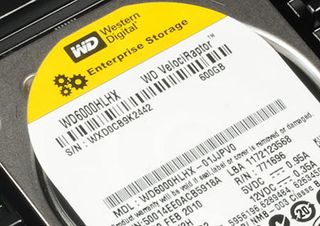VelociRaptor Returns: 6Gb/s, 600GB, And 10,000 RPM

VR200M Follows Up On VR150M
Western Digital’s Raptor family hit the enthusiast hard drive market like an asteroid in 2003, and has been a benchmark in high-end desktop storage ever since. With no direct competition in its spindle speed class, this 10,000 RPM hard drive remains a coveted choice for enthusiasts and IT professionals building entry-level servers, particularly now that the latest VelociRaptor models have arrived with 450GB and 600GB capacities, improved specifications, and increased performance.

Following Trends
Seagate's Barracuda ATA excited the mainstream drive world in 1997 when it took the industry's first stab at 7,200 RPM desktop storage. It only made sense that a 10,000 RPM evolution would eventually follow. Given that enterprise drives had been running at 10K since 1996 with the Seagate Cheetah, adoption was only a matter of time and production volume.
In a way, Western Digital was "lucky enough" to be unlucky with its SCSI enterprise drive business from 1997 to 1999. From these efforts were born the roots of the Raptor series. Other drive manufacturers didn’t want to risk cannibalizing their existing server/enterprise hard drive business, but WD had nothing to lose. This remains one of the main reasons why the Raptor family is the only 10K SATA family on today's market.
Although spindle speed hasn't changed since the original Raptor launched, there has been considerable progress on other fronts. Not only data density climbed but WD also transitioned the 3.5” Raptor into the 2.5” VelociRaptor, following the trend toward smaller drives for higher storage densities in server environments. This downsizing allows many more drives to be installed within the same dimensional footprint.
Setting New Records?
We were amazed to look back and realize that the VelociRaptor has been on the market for almost two years—one the longest component product life-cycles we've seen in recent years. Amazingly enough, the 300GB drive still does rather well against its competitors. Only a few 3.5” drives deliver better low-level performance. However, application benchmarks show that the latest 7,200 RPM models are a better choice nowadays, as they offer more than six times the capacity with increased performance at similar price points. WD knows this, too, which is why the company is now out to reclaim the performance crown.
Stay on the Cutting Edge
Join the experts who read Tom's Hardware for the inside track on enthusiast PC tech news — and have for over 25 years. We'll send breaking news and in-depth reviews of CPUs, GPUs, AI, maker hardware and more straight to your inbox.
Most Popular

